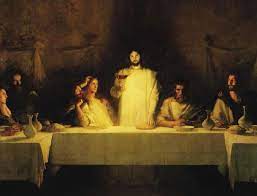All of us at some point or other must have wondered as to why we Catholics consume the Body and Blood of Christ! Today, the Solemnity of Corpus Christi (Latin for “Body of Christ” and short for Dies Sanctissimi Corporis et Sanguinis Domini Iesu Christi, or “Day of the Most Holy Body and Blood of Jesus Christ the Lord”) provides an answer to our concerns. It celebrates the Real Presence of the Body and Blood, Soul and Divinity of Jesus in the Holy Eucharist instituted on Maundy Thursday. On this day, with the shadow of the Cross by now on the liturgy, the Church is at a loss to express her joy at this ineffable gift; hence, a special feast.
This feast has an interesting history. Whereas from the earliest centuries, the Church believed that the elements used in celebrating the Eucharist changed into the Body and Blood of Christ, it was only at the Fourth Lateran Council (1215) that the doctrine was termed as “Transubstantiation”. In the year 1226, canoness and mystic Juliana of Liège had visions of Our Lord, who asked her to work towards the institution of such a feast but this happened only twenty years later and only locally. In 1263, at Bolsena, Italy, when a consecrated host that bled onto a corporal at the altar was considered a Eucharistic Miracle, by St Thomas of Aquinas, at his behest Pope Urban IV issued a papal bull Transiturus de hoc mundo (1264) (unprecedentedly) declaring a universal feast: that of Corpus Christi.
However, both before and after this watershed year, there was continued scepticism about the Body and Blood consumed in Holy Communion. Back in Jesus’ time, the Jews considered the very proposal a gross violation of the Mosaic law, but Jesus insisted that only “He who feeds on my flesh and drinks my blood has life eternal, and I will raise him up on the last day.” Early Christians were accused of cannibalism, so much so that, while persecution by Jews and Romans alike was rife, the faithful felt compelled to celebrate the Holy Eucharist in the privacy of their homes or in the catacombs.

Nonetheless, Jesus who is at the centre of all history had to be right. Note how Jesus’ radicality was born with Him in the manger (feeding trough) in Bethlehem (literally, ‘house of bread’), and was confirmed at the Last Supper when He declared unequivocally that He is the Bread of Life. On hearing objections, He did not soften his language but reinforced it. Obviously, taking Jesus at His word, the Church teaches that the Eucharist is not symbolic but real, in fact, “the source and summit of Christian life”. It is said that just as death came into the world by eating the forbidden fruit, eternal life is restored by eating the Bread of Life. If His flesh is food, by the same logic, His blood is drink.
Meanwhile, the First Reading (Deut. 8: 2-3, 14-16) speaks of manna – a perishable bread! Moses told his people that by this God made them know “that man does not live by bread alone, but that man lives by everything that proceeds out of the mouth of the Lord” (which, in the New Testament, is also Jesus’ wise retort to Satan in the wilderness). Moses was only exhorting his people to remember God not only in bad times – when they need His help – but also in good times, when they tended to forget Him.
In the Second Reading (1 Cor 10: 16-17), St Paul too highlights the sublime mystery that is the Holy Eucharist. He shows the sheer incompatibility of the Christian eucharistic feast and pagan sacrificial banquets. The Eucharist is truly sacrificial in nature and bears the Real Presence of Christ. The Apostle of the Gentiles draws our attention to the power of the Eucharist – that “because there is one bread, we who are many are one body, for we all partake of one bread.” The Israelites of old merely consumed the offerings; Christians who consume the Body and Blood of Christ gain eternal life.
Finally, Joan Carroll Cruz’s Eucharistic Miracles and Eucharistic Phenomenon in the Lives of the Saints (Tan Books: 1991) and others on the same topic will let us see, concretely, how “real” the Presence is. While the Holy Trinity is a central tenet of our faith, as we saw last Sunday, the Holy Eucharist, being a real communion with Christ, is a central feature of ecclesial life and most worthy of perpetual adoration.
Amem!